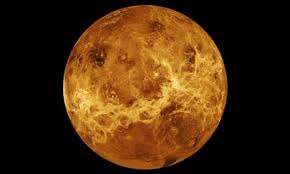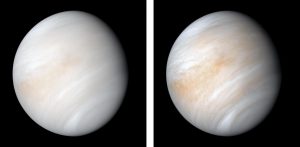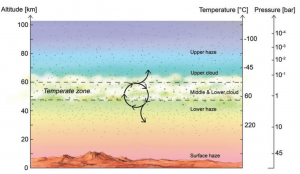Life on Venus: Is It Actually Possible?
Is alien life possible on Earth’s sister planet? MIT scientists, NASA, and other astronomers comment on the possibility.

Magellan Spacecraft, Pioneer Venus Orbiter
A composite image of Venus created using data from Nasa’s Magellan spacecraft and Pioneer Venus Orbiter. Photograph: NASA/Reuters
On September 14th, National Geographic journalist Nadia Drake released an article detailing exciting news about our sister planet, Venus; traces of phosphine, a gas only known to be created by living organisms, was detected in the planet’s atmosphere.

The idea that life existed, or still exists, on planets within our solar system is not a new idea. In the 1960s, beloved American astronomer Carl Sagan supplied an idea that Venus could be the holder of the closest thing to life that a planet other than Earth could support. Sagan, who held many titles related to science including but not limited to astrobiology, noted that Venus had many of the prerequisites of photosynthesis. He was also open about his theory of life within Venus’ habitable cloud strip, a small area between the two extreme temperatures in the planet’s mesosphere, 50km above the planet’s uninhabitable surface. “If small amounts of minerals are stirred up to the clouds from the surface, it is by no means difficult to imagine an indigenous biology in the clouds of Venus,” he wrote in Nature in 1967 — two years before NASA landed on the moon. “While the surface conditions of Venus make the hypothesis of life there implausible, the clouds of Venus are a different story altogether.”
The findings of phosphine on Venus is exciting for two main reasons. One, phosphine is a rancid-smelling, life-annihilating gas that is created using a strong base, or hot water having a reaction with white phosphorus (Ca3P2.). It can also be created with the reaction between water and calcium phosphide (NH3). The gas is created through industrial body processes, and by bacteria. Ironically, it can kill living organisms reliant upon oxygen, but is survivable and created by those who don’t. It is considered a key “biosignature”, things that indicate that life exists or existed, to search for on planets or areas of the universe.
Two, since phosphine was found, what does that mean for life on Venus? While it indicates a strong likelihood of life, it does not mean that scientists will be running into little green men or creatures who look like they belong swaddled in blankets, stuffed into the front basket of a bicycle. The likely suspect for the creation of phosphine would be microorganisms and bacteria. The processes bacteria go through can create mass amounts of phosphine if they interact with their surroundings like bacteria on Earth do. The microbial activity that creates phosphine relies upon processes that do not rely on oxygen, so the likelihood of life on Venus would be activity within the clouds and not upon the hellish landscape of the planet itself.

Photo credit to Sara Seager, Astrobiology hypothesis article. (figure 1 in Seager et al. (2020) Astrobiology vol. 21)
If life exists on Venus, it would be a ginormous step in the progressive direction for science. For decades, scientists have been searching for life to see how it may have evolved while we, as a civilization, also evolved into what we are today, as well as the world around us. Billions of years leave plenty to the imagination, and even the smallest forms of life could completely change science as the world knows it if the way they function is entirely different to how life on Earth functions. If new life, proof of microbial activity, is found on Venus, the world as a whole will be introduced to new forms of life during the age of creation in the world of science.
Scientists cannot say that phosphine is indisputable evidence of life, however. Sara Seager, an MIT scientist who studies explonet atmospheres, spoke on the topic. “We are claiming the confident detection of phosphine gas whose existence is a mystery,” she said. “Phosphine can be produced by some (non-biological) processes on Venus, but only in such incredibly tiny amounts it’s not enough to explain our observation. So we’re left with this other exciting, enticing possibility: that perhaps there is some kind of life in Venus’ clouds.”
Venus has been explored by rovers before, by the US and by the late USSR and Russia. Scientists know what the crust of Venus looks like, what it’s made of, and the way it was created. If now, scientists have access to more data on the makeup of Venusian clouds, it’s atmosphere, and can extrapolate data that proves there is living activity within it, they will be one step closer to figuring out how life can survive on desolate landscapes and will be even closer to figuring out how to possibly colonize other habitable planets within our solar system.
Sources
https://www.nature.com/articles/2151259a0.epdf?sharing_token=uT8mthNYiv_IaD1-vP7P_dRgN0jAjWel9jnR3ZoTv0M2gOxt8ySkqH8PBxEPXPeMbPBJkhsn7i6DAhpaJnflo3Y_DJ-UuvMH5dpcRgd7wLAsRJcvsPDZ_H1jgESgMcpmVobkxJzG4EgflXwPU6Kuv3MmpR0FzUqPxXZ9GPqkA07VVr9KMxVqiBkRvc82qN3IrXh48pun1r8WWweLKHWlEHiRbftTq2-_IpekkKJpkGcEFoAJa60_66zEQOZnugNvLaoThZRYEu5ZeRXMDUCrlNzch4WgrJvQU3Q0w-qTc85JD02RhGp6hj–P5Mztp4o&tracking_referrer=www.npr.org
https://www.npr.org/2020/09/14/912619891/a-possible-sign-of-life-right-next-door-to-earth-on-venus
https://www.cbsnews.com/news/venus-life-phosiphine-gas-scientists/
https://www.nationalgeographic.com/science/2020/09/possible-sign-of-life-found-on-venus-phosphine-gas/
https://www.nature.com/articles/2161198a0
